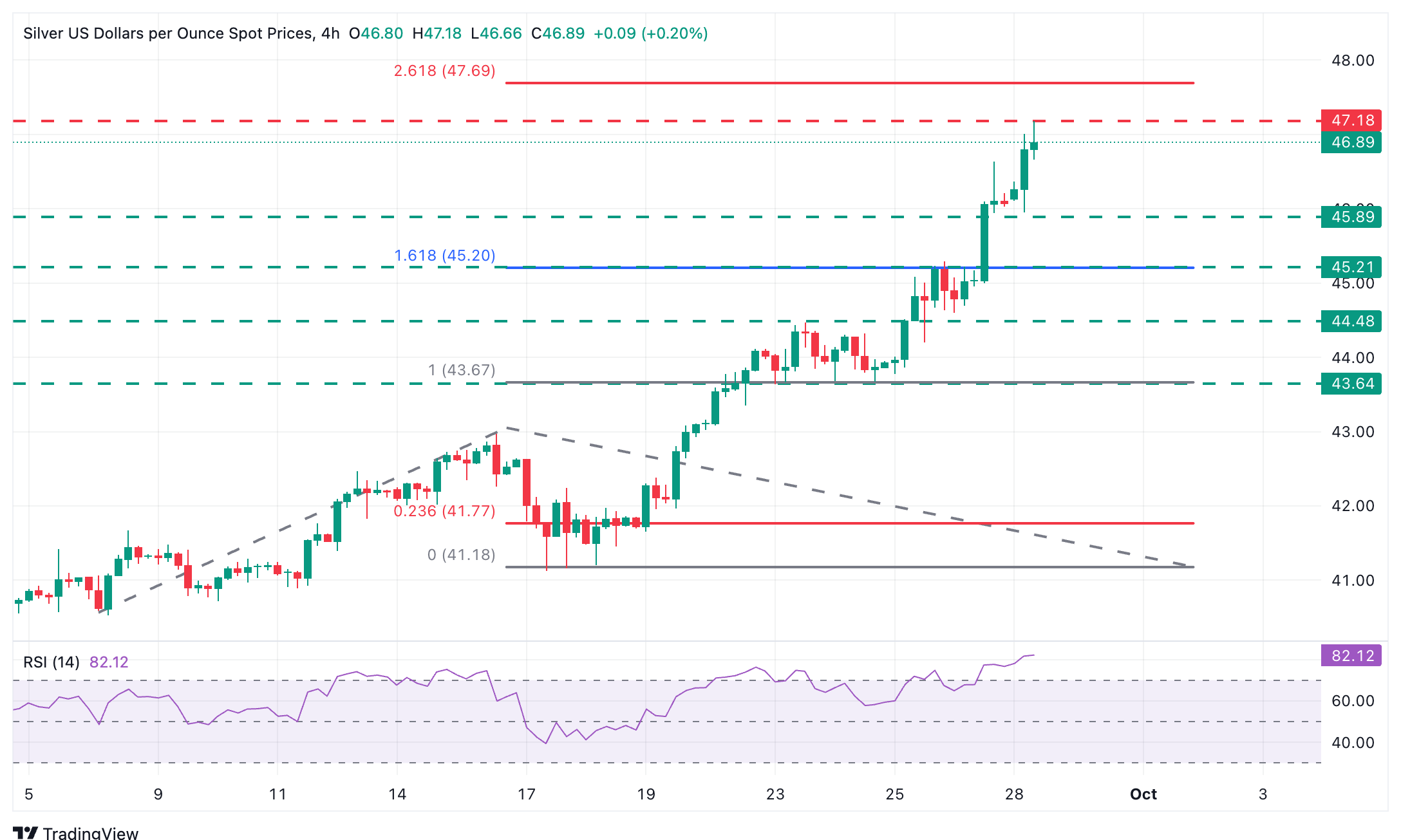Silver Price Forecast: XAG/USD rallies to $47.00 with US Government shutdown looming
- Silver remains bid on US Dollar weakness, at 4-year highs, near $47.00.
- Investors' concern about a US Government shutdown has given an additional boost to precious metals.
- XAG/USD is at extremely overbought levels after rallying about 7% over the last three days.
Silver (XAG/USD) continues to rise on Monday. The white metal appreciates by about 1.8% on the day, and trades as the US Dollar and US Treasury yields retreat, with investors taking positions ahead of the $46.95, after having hit fresh multi-year highs at $47.18 in the early European trading session.
Precious metals are thriving on Monday, as the US Dollar and US Treasury yields retreat, with investors taking positions ahead of the highly likely closure of the US federal government on Wednesday.
Beyond that, the moderate US PCE Price Index figures seen on Friday keep concerns of a sharp inflationary impact from tariffs subdued, at least for now, and keep hopes of back-to-back Fed rate cuts alive. This is another source of weakness for US yields and the US Dollar.
Technical Analysis: Silver reaches extremely overbought levels

Fundamental drivers continue to boost Silver higher, but technical indicators indicate extremely overbought levels, which should serve as a warning for buyers. The pair has rallied nearly 7% in the last three trading days and about 13% in the last two weeks. Such sharp rallies tend to have similar corrections.
On the upside, the intraday high, around the $47.20 area, might offer some resistance. Above here, a Fibonacci tool sho¡ws the 261.8% extension of the mid-September bullish run, at $47.70.
A bearish reaction from current levels might find support at the $45.96 intraday lows ahead of the previous long-term highs, at $45.30 (September 25 high) and $44.45 (September 23 high).
Silver FAQs
Silver is a precious metal highly traded among investors. It has been historically used as a store of value and a medium of exchange. Although less popular than Gold, traders may turn to Silver to diversify their investment portfolio, for its intrinsic value or as a potential hedge during high-inflation periods. Investors can buy physical Silver, in coins or in bars, or trade it through vehicles such as Exchange Traded Funds, which track its price on international markets.
Silver prices can move due to a wide range of factors. Geopolitical instability or fears of a deep recession can make Silver price escalate due to its safe-haven status, although to a lesser extent than Gold's. As a yieldless asset, Silver tends to rise with lower interest rates. Its moves also depend on how the US Dollar (USD) behaves as the asset is priced in dollars (XAG/USD). A strong Dollar tends to keep the price of Silver at bay, whereas a weaker Dollar is likely to propel prices up. Other factors such as investment demand, mining supply – Silver is much more abundant than Gold – and recycling rates can also affect prices.
Silver is widely used in industry, particularly in sectors such as electronics or solar energy, as it has one of the highest electric conductivity of all metals – more than Copper and Gold. A surge in demand can increase prices, while a decline tends to lower them. Dynamics in the US, Chinese and Indian economies can also contribute to price swings: for the US and particularly China, their big industrial sectors use Silver in various processes; in India, consumers’ demand for the precious metal for jewellery also plays a key role in setting prices.
Silver prices tend to follow Gold's moves. When Gold prices rise, Silver typically follows suit, as their status as safe-haven assets is similar. The Gold/Silver ratio, which shows the number of ounces of Silver needed to equal the value of one ounce of Gold, may help to determine the relative valuation between both metals. Some investors may consider a high ratio as an indicator that Silver is undervalued, or Gold is overvalued. On the contrary, a low ratio might suggest that Gold is undervalued relative to Silver.

